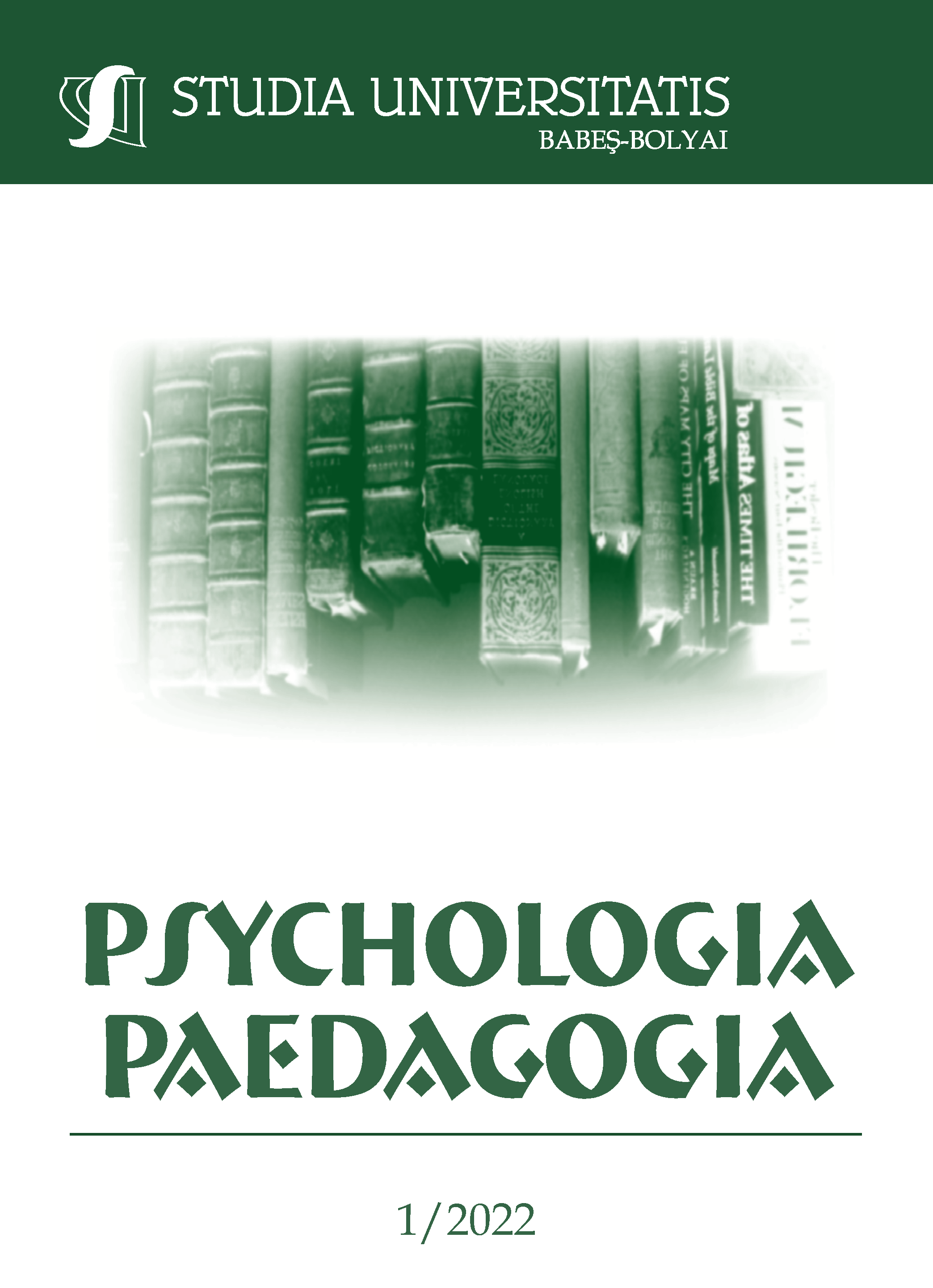STUDY ON INTEGRATING CHILDREN’S STORIES FOR LEARNING NUMERATION IN ROMANIAN PRESCHOOL EDUCATION
DOI:
https://doi.org/10.24193/subbpsyped.2022.1.06Keywords:
Children’s stories, numeration, kindergarten, survey, RomaniaAbstract
The new Curriculum for preschool education in Romania, introduced in 2019, launches a challenge for educators: the active involvement of preschoolers in the activities carried out in kindergarten, their preparation for a social life based on cooperation, communication and action. One of the recommendations of the new curriculum is to organize the learning content in an integrated way. In this context, we intended to study how pre-school teachers’ approach in an integrated way the teaching of numeration through stories, their role and importance. The data were collected using the survey method based on a questionnaire in Google Drive. The questionnaire was completed voluntarily and anonymously by 101 teachers for preschool education. Over 88% of respondents consider that stories contribute to a large or to a very large extent to learning the numeration and that preschoolers are actively involved in learning activities in which stories are used, obtaining very good mathematical performances. Almost all preschool teachers who attended the study found the use of stories in learning to be very beneficial, even if they face to some difficulties, including the lack of a collection of consacrated stories for learning numeration.
Received: 2022 March 05; Revised: 2022 March 25; Accepted: 2022 March 28; Available online: 2022 May 5; Available print: 2022 May 30
References
Albool, R. M. (2012). The Effect of Utilizing Storytelling Strategy in Teaching Mathematics on Grade Four Students’ Achievement and Motivation towards Learning Mathematics, Proceedings of the International Conference: The Future of Education, 1-4.
Casey, B., Erkut, S., Ceder, I. & Young, J. M. (2008). Use of a storytelling context to improve girls' and boys' geometry skills in kindergarten, Journal of Applied Developmental Psychology, vol. 29, no. 1, p. 29-48.
Demeny, P., Zsoldos-Marchis, I. (2020). Mathematical stories written by pre-service preschool and primary school teachers: evaluation for literary and mathematical quality, EDULEARN21 Proceedings, p. 9852-9860.
Furner, J. M. (2017a). Helping all Students Become Einstein’s using Bibliotherapy when Teaching Mathematics to Prepare Students for a STEM World, Pedagogical Research, vol. 2, no. 1, 1-11. Retrieved December 20, 2021, from https://dx.doi.org/10.20897/pedre.201701.
Furner, J. M. (2017b). Using Fairy Tales and Children’s Literature in the Math Classroom: Helping All Students Become Einstein’s in a STEM World, Journal of Advances in Education Research, vol. 2, no. 2, 103-112. Retrieved December 20, 2021, from https://dx.doi.org/10.22606/jaer.2017.22006.
Heuvel-Panhuizen, M. van den, Elia, I. & Robitzsch, A. (2016). Effects of reading picture books on kindergartners’ mathematics performance, Educational Psychology, vol. 36, no. 2, 323-346. DOI: 10.1080/01443410.2014.963029
Lemonidis, C. & Kaiafa, I. (2019). The Effect of Using Storytelling Strategy on Students’ Performance in Fractions, Journal of Education and Learning, vol. 8, no. 2, 165-175.
Magdaș, I. (2014). Didactica matematicii pentru învățământul primar și preșcolar. Actualitate și perspective [Didactics of mathematics for primary and preschool education. Actuality and perspectives], Revised Second Edition. Presa Universitară Clujeană.
McAndrew, E. M., Morris, W. L. & Fennell, F. (2017). Geometry-Related Children's Literature Improves the Geometry Achievement and Attitudes of Second-Grade Students, School Science and Mathematics, vol. 117, no. 1-2, 34-51. Retrieved December 20, 2021, from https://dx.doi.org/10.1111/ssm.12202.
Ministerul Educației Naționale [Ministry of National Education]. (2019). Curriculum pentru educația timpurie [Curriculum for early education], Annex no. 4.694/2.08.2019. to the Minister of National Education. Retrieved December 15, 2021, from https://www.edu.ro/sites/default/files/Curriculum%20ET_2019_aug.pdf
Petrovici, C. (2014). Didactica activităților matematice în grădiniță [Didactics of Mathematical activities in kindergarten], Collegium Polirom.
Poveste [Story] (n.d.). In Dictionar Explicativ al limbii romane [Explanatory Dictionary of the Romanian language]. Retrieved December 20, 2021, from https://dexonline.ro/definitie/poveste
Skoumpourdi, C. & Mpakopoulou, I. (2011). The Prints: A Picture Book for Pre-Formal Geometry, Early Childhood Education Journal, vol. 39, 197–206.
Story (n.d.). In Cambridge Dictionary. Retrieved December 20, 2021, from https://dictionary.cambridge.org/dictionary/english/story
Story (n.d.). In MacMillan Dictionary. Retrieved December 20, 2021, from https://www.macmillandictionary.com/dictionary/british/story
Story (n.d.). In Merriam-Webster. Retrieved December 20, 2021, from https://www.merriam-webster.com/dictionary/story
Story (n.d.). In Oxford Learner’s Dictionaries. Retrieved December 20, 2021, from https://www.oxfordlearnersdictionaries.com/definition/english/story
Trakulphadetkrai, N. V. (2015). The construction of the ‘Primary Teachers’ Beliefs concerning the Integration of Children’s Literature in Mathematics Learning and Teaching’ (PTB-ICLMLT) Framework: Findings from a pilot study, Paper presented at the British Educational Research Association (BERA) Annual Conference, Belfast, UK, 15th-17th September 2015.
Tucker, C., Boggan, M. & Harper, S. (2010). Using children’s literature to teach measurement, Reading Improvement, vol. 47, no. 3, 154-161.
Wilburne, J. M., Keat, J. B. & Napoli, M. P. (2011). Cowboys Count, Monkeys Measure, and Princesses Problem Solve: Building Early Math Skills through Storybooks. Paul H. Brookes Publishing Co., Inc.
Zazkis R. & Liljedahl, P. (2009). Teaching mathematics as storytelling. The Netherlands: Sense Publishers, 2009.
Zsoldos-Marchis, I. (2020a). Pre-service primary school teachers’ views on children stories in mathematics education, Proceedings of the 13th annual International Conference of Education, Research and Innovation, p. 9072-9080.
Zsoldos-Marchis, I. (2020b). Children stories for teaching mathematics in preschool written by primary and preschool pedagogy specialization students, Proceedings of the 14th International Technology Education and Development Conference, p. 8434-8439.
Downloads
Published
How to Cite
Issue
Section
License
Copyright (c) 2022 Studia Universitatis Babeș-Bolyai Psychologia-Paedagogia

This work is licensed under a Creative Commons Attribution-NonCommercial-NoDerivatives 4.0 International License.


